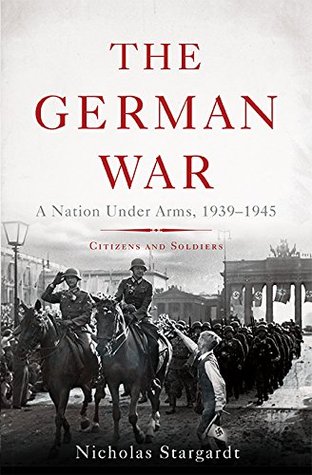More on this book
Community
Kindle Notes & Highlights
Read between
December 6 - December 12, 2019
What fuelled the sense of crisis in the summer of 1943 was a widespread fear that Germans could not escape the consequences of a ruthless racial war of their own making.
However unpopular the war became, it still remained legitimate – more so than Nazism itself. Germany’s mid-war crises resulted not in defeatism but in a hardening of social attitudes.
The first lesson of 1914–18 was not to repeat it. When war and rationing came, both were greeted with profound gloom. In the first winter, city-dwellers compared shortages of food, clothing and, above all, heating coal with the winters of 1916 and 1917, grumbling about chronic shortages.
Party membership rose from 850,000 at the end of 1932 to 5.5 million on the eve of war. By that time, the National Socialist Women’s League had 2.3 million members and the Hitler Youth and League of German Girls 8.7 million, and they all ran ideological training courses, from evening get-togethers to week-long summer camps.
Overall by 1939, two-thirds of the population signed up to at least one of the Party’s mass organisations.11
On the eve of war most Germans belonged to both an established Christian denomination and a Nazi Party organisation; far more of them – 94 per cent – remained members of a Catholic or Protestant church than the two-thirds who belonged to Nazi organisations. The churches were the most important independent civic institutions in Germany,
When war broke out in September 1939, it was deeply unpopular in Germany. Yet there was no great soul-searching about why it had occurred. Whereas in Britain and France it was self-evident that Hitler was waging a war of conquest by launching an unprovoked attack on Poland, it was equally obvious to most Germans that they were caught up in a war of national defence, forced upon them by Allied machinations and Polish aggression.
Everyone in Germany saw the Second World War through the lens of the First, whether or not they had lived through it.
What bound fathers and sons together was more than shared experience. It was a sense of intergenerational responsibility. The sons had to achieve what their fathers had failed to do. They had to break the cycle of repetition, which condemned each generation to fight in Russia.
As Germans closed ranks, they convinced themselves that war had been forced upon them.
Unlike Stalin’s regime, which was willing to wage war on the majority of its population in order to push through its social revolution, Hitler’s dictatorship continued to calibrate its violence so that the majority of Germans did not feel
the Gestapo had never had a large staff and depended to a large extent on public compliance and denunciations to assist it in spotting transgressors.
Labels pasted on all new sets warned that listening to foreign broadcasts was a ‘crime against national security’, but the ban was unenforceable.
The number of Germans murdered in the psychiatric asylums exceeded that of any other group of domestic victims of Nazi persecution.


